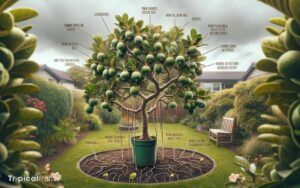How to Prune a Feijoa Tree? 5 Easy Steps!
Pruning a feijoa tree is a crucial horticultural task that, when done correctly, can significantly improve the tree’s health, fruit production, and overall shape.
The best time to prune is during the late winter or early spring before the new growth starts. This timing helps prevent tree damage and supports new development.
Utilize appropriate tools such as sharp secateurs, loppers, and saws for clean cuts. Key pruning steps include removing dead or diseased wood, cutting back crossing branches, and thinning the canopy to boost sunlight penetration and air circulation.
After trimming, maintain the tree with adequate watering and mulching to facilitate its recovery and growth.
Effective pruning of a feijoa tree includes:
By following these steps, you’re helping your feijoa tree to produce more fruit and maintain a pleasing appearance.
Ensure your feijoa tree’s vitality with strategic pruning for enhanced fruit yield and tree structure.
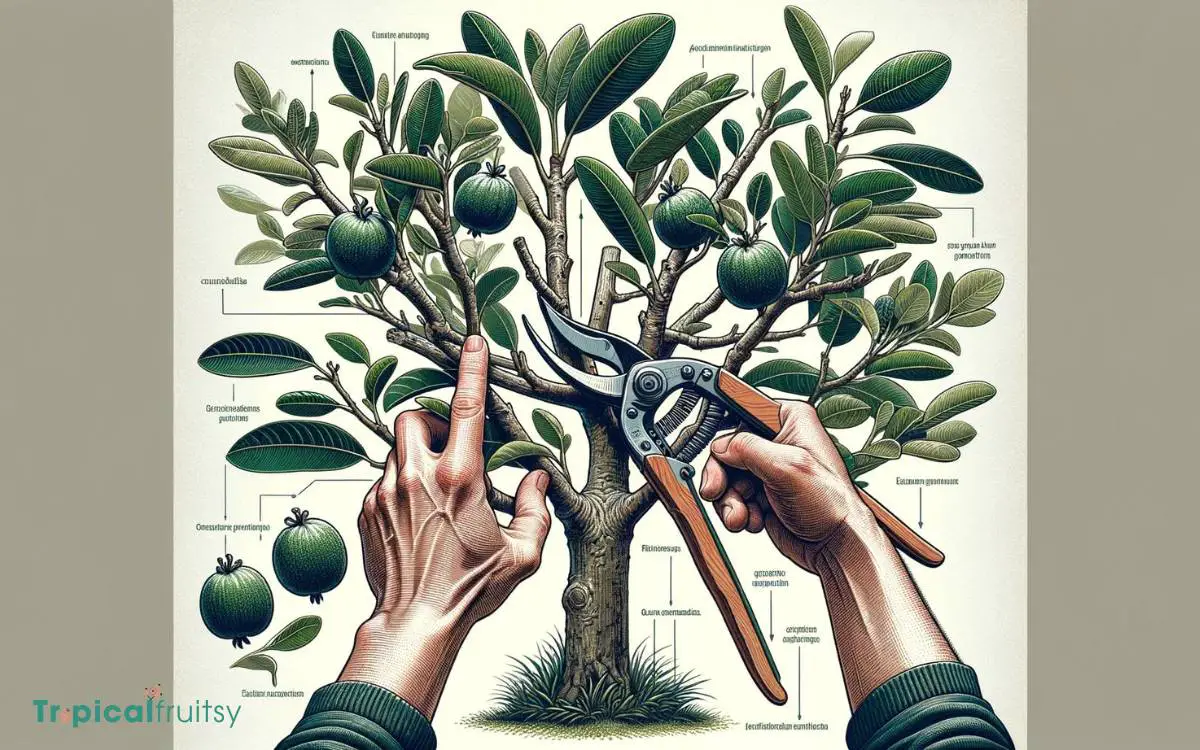
Key Takeaway
Pruning Guide for Feijoa Trees: Enhance Health and Yield
| Task | Description | Timing | Tools Needed | Aftercare |
|---|---|---|---|---|
| Assess Tree | Examine for dead, diseased, or crossing branches | Before pruning | None | None |
| Prune Dead/Diseased Wood | Remove unhealthy branches to prevent spread | Late winter/early spring | Secateurs, Loppers, Saw | Watering, Mulching |
| Thin Canopy | Cut back to improve light and air flow | Late winter/early spring | Secateurs, Loppers | Watering, Mulching |
| Shape Tree | Trim for desired form and structure | Late winter/early spring | Secateurs, Loppers, Saw | Watering, Mulching |
| Aftercare | Provide sufficient water and mulch for recovery | Post-pruning | None | Mulch, Water |
Understanding Pruning Basics
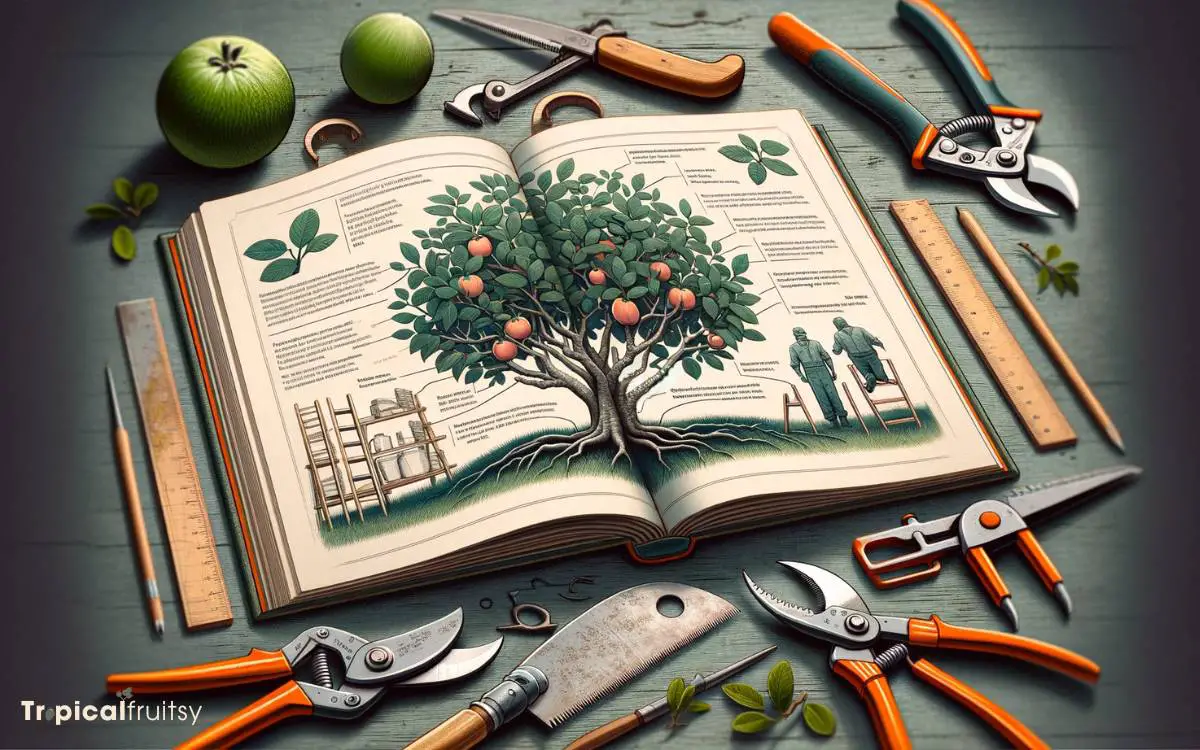
Pruning is an essential practice to maintain your feijoa tree’s health, encouraging vigorous growth and optimal fruit production. The process involves selectively removing parts of the tree, such as branches, buds, or roots.
Effective pruning provides sunlight penetration and air circulation, which are critical for the prevention of disease.
It’s best to prune feijoa trees during their dormant season, typically in late winter or early spring, to minimize stress and sap loss. One must ensure to use clean, sharp tools to make precise cuts that heal quickly.
It’s crucial to identify and remove any dead or diseased wood, thin out crowded branches, and shape the tree to an open-center structure. This encourages a strong framework that supports fruiting branches and facilitates harvesting.
Step 1: Identifying the Best Season
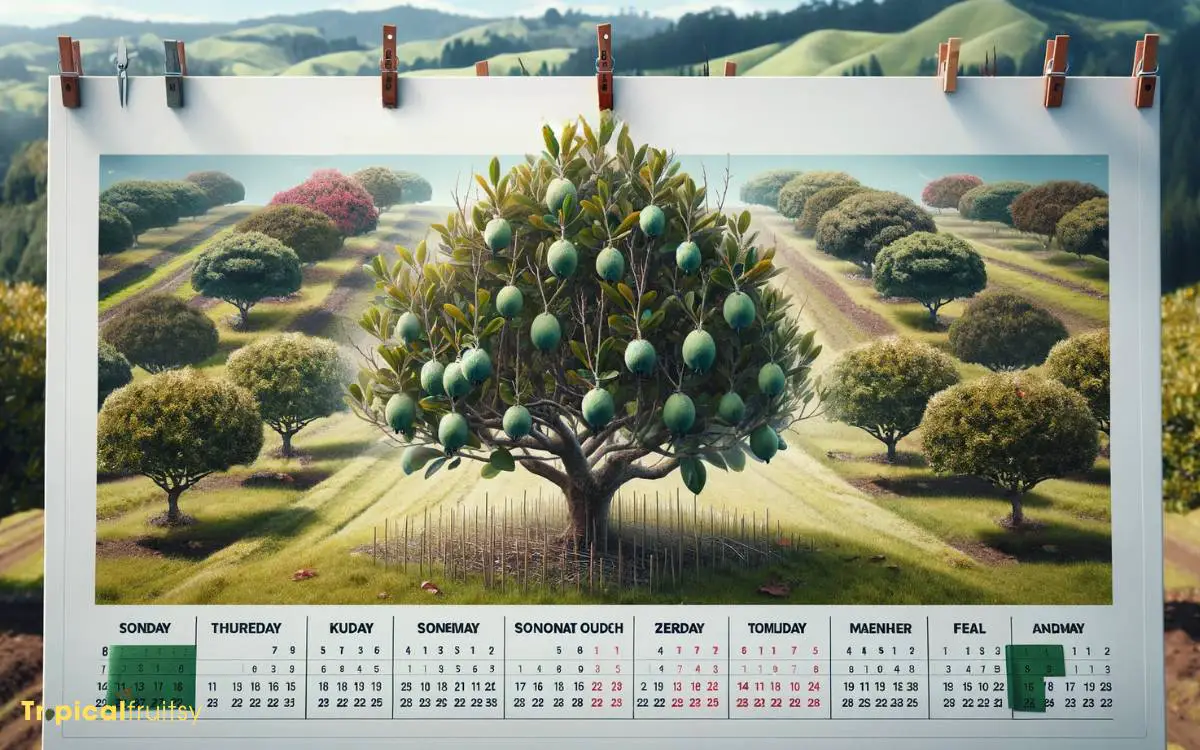
The optimal pruning time for a feijoa tree is crucial to maximize fruit production and maintain tree health. Pruning should align with the tree’s seasonal growth cycles to ensure recovery and growth aren’t impeded.
Gardeners typically perform this task in late winter or early spring before the onset of new growth.
Optimal Pruning Time
Feijoa trees should ideally be pruned in the late winter to early spring, just before new growth starts. This timing allows gardeners to shape the tree and remove any dead or diseased wood without impeding the upcoming season’s growth.
Pruning during this dormant period minimizes stress on the tree, as sap flow isn’t as vigorous, which reduces the risk of disease transmission and excessive loss of sap from the cuts.
It’s crucial to adhere to this optimal pruning window to ensure the health and productivity of the feijoa tree. Pruning too late in the spring can remove blossoms and therefore potential fruit.
Conversely, pruning too early in winter could expose fresh cuts to harsh conditions, potentially damaging the tree.
Seasonal Growth Cycles
Understanding a feijoa tree’s seasonal growth cycles is crucial for identifying the best season to prune for optimum health and fruit production.
Feijoa trees, also known as pineapple guavas, typically exhibit a flush of new growth in the spring followed by fruit development. Pruning should occur post-harvest in the late fall or early winter when the tree is dormant.
This timing prevents unnecessary stress on the tree and allows for the removal of dead or diseased wood without impacting the forthcoming bloom. It also preserves the flower buds set for the next season’s fruit.
Gardeners must note that heavy winter pruning can lead to vigorous spring growth, which may require thinning to maintain the desired tree structure and fruit size.
Step 2: Selecting the Right Tools
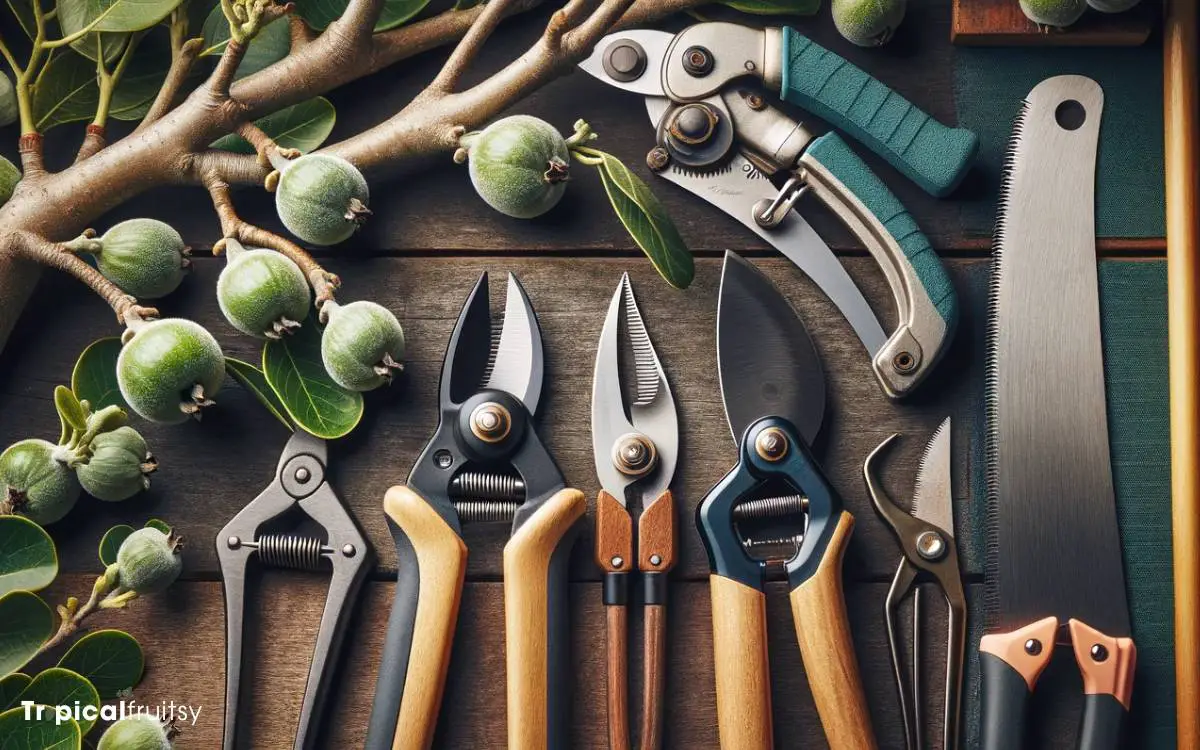
To ensure clean cuts, one must choose the appropriate cutting tools for pruning a feijoa tree. It’s critical to maintain the sharpness of these tools to facilitate efficient and safe trimming.
Selecting implements with ergonomic handle designs can reduce fatigue and improve control during the pruning process.
Appropriate Cutting Tools
Why should you pick the right tools when the health of your feijoa tree hinges on clean, precise cuts? Selecting appropriate cutting tools is crucial for the tree’s recovery and growth.
One needs bypass pruners for cutting smaller branches; their scissor-like action ensures a sharp, clean slice without crushing plant tissues.
For larger limbs, a pruning saw with fine teeth is ideal, allowing for controlled, accurate cuts that promote swift healing.
Loppers are the tool of choice for intermediate-sized branches, offering leverage to make pruning less labor-intensive.
It’s essential these tools are of high quality, well-maintained, and sanitized before use to minimize the risk of disease transmission. Dull or improper tools can cause jagged cuts, leading to unnecessary stress and potential disease entry points.
Maintenance of Sharpness
Keeping your pruning tools sharp ensures they’ll cut through feijoa branches with ease, reducing damage to the tree. A keen edge on blades promotes clean, swift cuts that facilitate rapid healing for the pruned limbs.
It’s crucial to regularly inspect your tools for signs of dullness or wear. Utilize a sharpening stone or file specifically designed for pruning equipment.
Follow the original angle of the cutting edge while sharpening, and maintain consistent pressure to avoid irregularities on the blade. After sharpening, a light application of oil helps prevent rust and preserves the sharpness of the blade.
With well-maintained tools, the pruning process becomes not only efficient but also less labor-intensive.
Ergonomic Handle Design
Selecting a pruning tool with an ergonomic handle design is essential for comfort and efficiency during the maintenance of a feijoa tree.
Ergonomic tools are designed to fit comfortably in the hand, reducing the risk of strain or injury over prolonged use.
They often feature non-slip grips and are shaped to follow the natural contours of the hand, thereby maximizing control and minimizing fatigue.
Here’s a comparison of tool features:
| Feature | Benefit | Example |
|---|---|---|
| Contoured Grip | Reduces hand fatigue | ErgoPrune Shears |
| Non-Slip Coating | Enhances grip stability | GripMaster Loppers |
| Adjustable Handle | Accommodates different hand sizes | FlexFit Pruners |
| Lightweight Material | Lessens arm strain | CarbonLite Snips |
| Shock-Absorbing Padding | Minimizes impact stress | SoftShock Clippers |
Step 3: Assessing Your Feijoa Tree
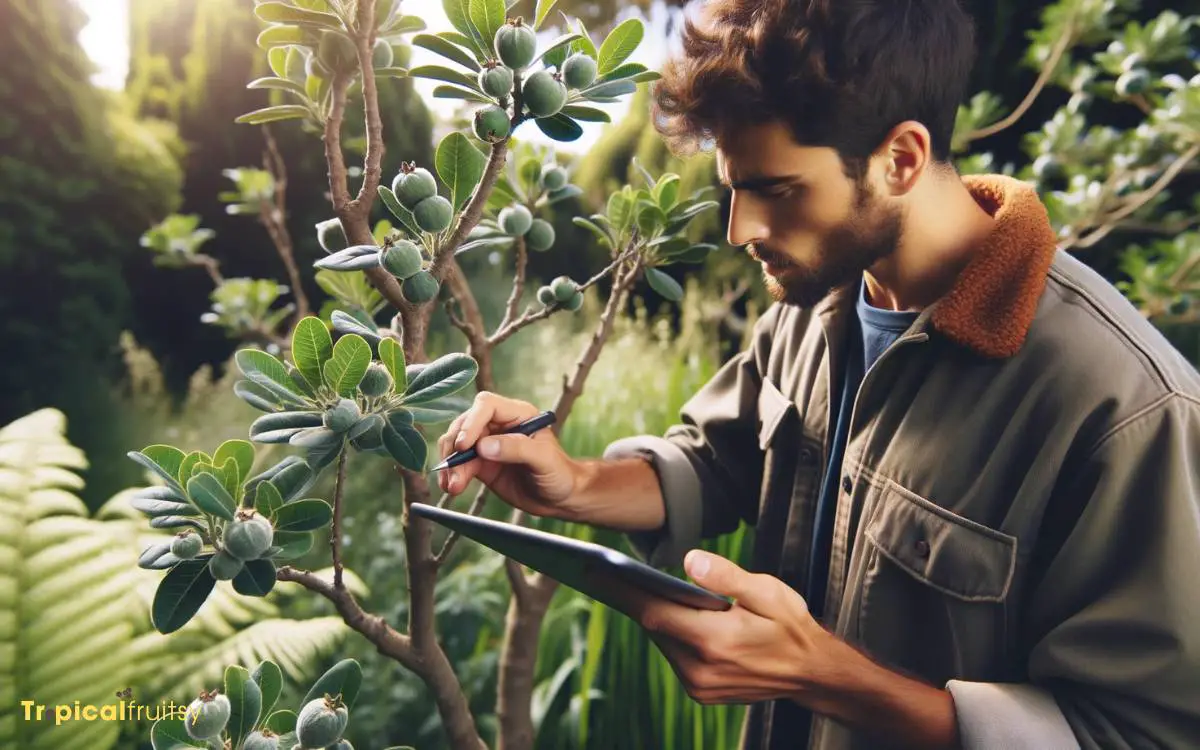
A thorough inspection of your feijoa tree’s structure, health, and growth patterns is the first step in effective pruning. One should evaluate the tree for dead or diseased branches, which require removal to maintain the tree’s vitality.
It’s also crucial to identify any branches that cross or rub against each other, as this can cause wounds and make the tree susceptible to infections.
Observing the angle of branch growth is important; optimal angles promote strength and fruit production.
The grower must also assess the tree’s overall shape and balance, aiming for an open canopy that allows light penetration and air circulation.
This comprehensive assessment equips one with the knowledge to make informed decisions in the subsequent phase of pruning, specifically focusing on making the correct cuts.
Step 4: Making the Correct Cuts
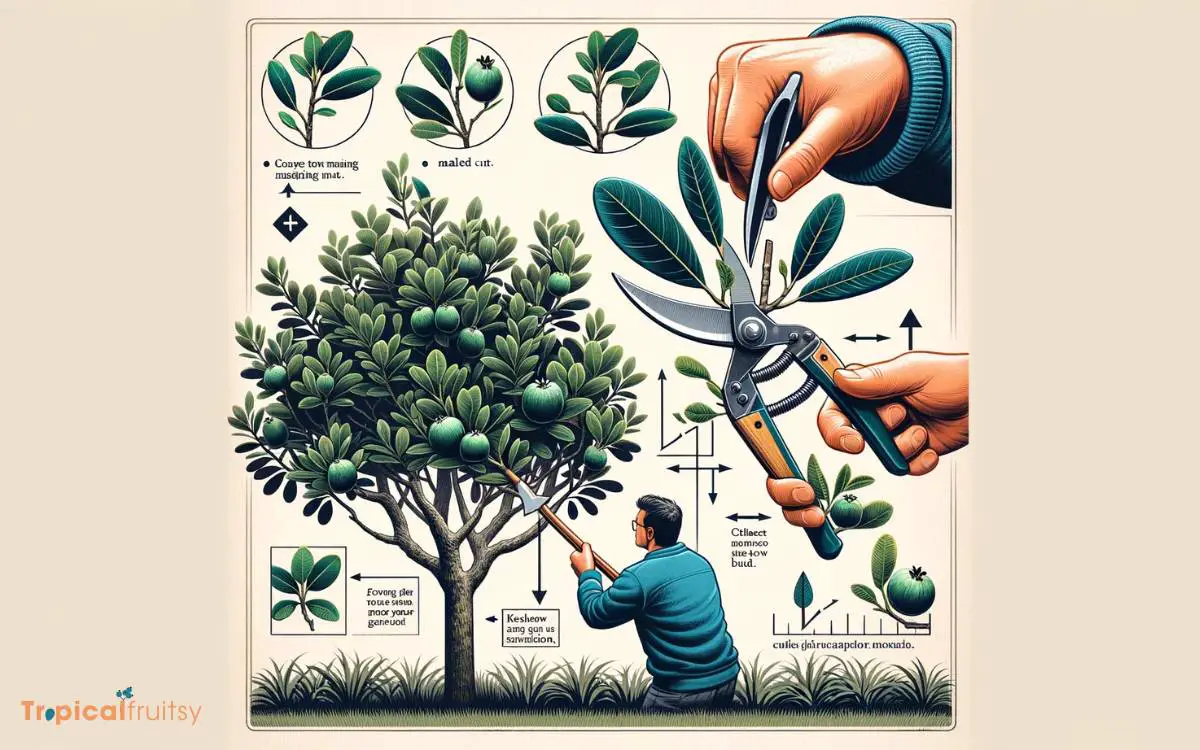
After assessing the feijoa tree’s condition, it’s crucial to identify and carefully remove any branches that are dead, diseased, or damaged. The correct pruning cuts are vital for the health of the tree and to stimulate productive growth.
Here are some guidelines:
- Make clean cuts: Use sharp, sterilized pruning shears to avoid tearing the bark.
- Angle your cuts: Cut branches at a 45-degree angle, just above an outward-facing bud or node.
- Avoid stubs: Ensure cuts are close to the trunk but not flush, leaving the branch collar intact to facilitate healing.
Pruning not only shapes the tree but also encourages the growth of new, healthy fruit-bearing wood.
With the correct cuts made, gardeners can next focus on the post-pruning care tips to ensure a speedy recovery for the tree.
Step 5: Post-Pruning Care Tips
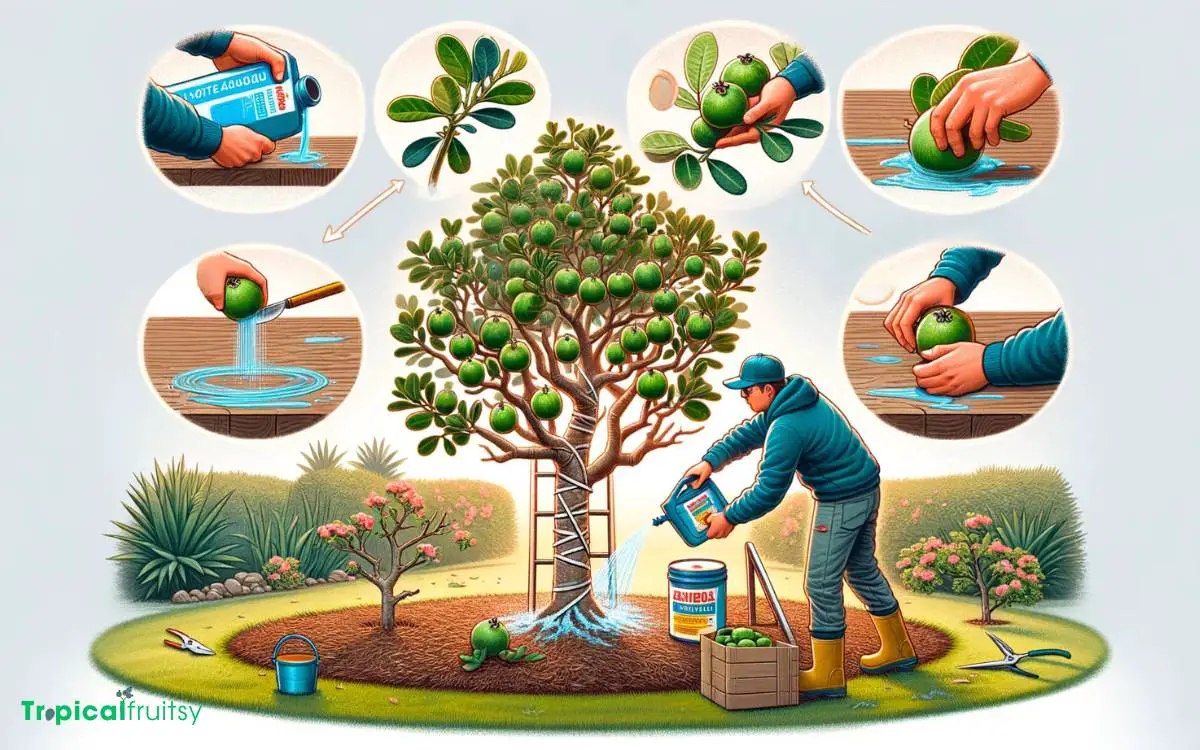
Upon completing the pruning process, it’s essential to provide your feijoa tree with proper care to support its recovery and growth.
Immediately after pruning, apply a balanced, slow-release fertilizer to replenish nutrients and encourage healthy foliage.
Ensure the tree receives adequate water, especially in dry conditions, but avoid overwatering which can lead to root issues.
Inspect the tree regularly for signs of stress or disease, as freshly cut limbs can be more susceptible to infection. If necessary, treat wounds with a suitable pruning sealant to prevent disease entry.
Mulching around the base of the tree helps retain soil moisture and regulates temperature, but keep mulch away from the trunk to prevent rot. Consistent post-pruning care optimizes the feijoa tree’s health and productivity.
Conclusion
In the dance of the seasons, a well-pruned feijoa tree pirouettes into productivity. With the right tools in hand and timing in mind, gardeners sculpt their trees, careful to make precise cuts that encourage vigorous growth.
As the final snips fall away, they bestow upon their green charges post-pruning care, ensuring a bountiful future harvest. The tree stands, a testament to the gardener’s technical artistry, ready to flourish under the sun’s nurturing gaze.

